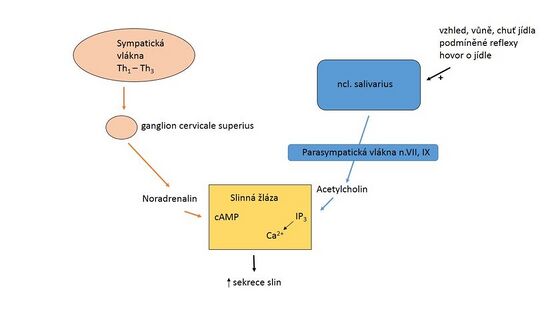Salivary secretion control
Saliva secretion is ensured by three pairs of large salivary glands and a number of small salivary glands that are scattered throughout the oral cavity. It is triggered reflexively by the autonomic nervous system.
Stimuli inducing secretion[edit | edit source]
- visual,
- olfactory,
- taste,
- mechanical (e.g. food touches the mucous membrane, chewing),
- conditioned reflexes,
- others (e.g. talk about food).
Secretion suppressing factors[edit | edit source]
- dehydration,
- fatigue,
- sleep,
- fear.
Control Mechanisms[edit | edit source]
Saliva secretion is stimulated by sympathetic and parasympathetic. The parasympathetic effect is more pronounced.
PNS[edit | edit source]
Acetylcholine is released from the endings of parasympathetic fibers, which binds to muscarinic G-protein coupled receptors.
Phospholipase C is activated, which further cleaves phosphatidylinositol-4,5-bisphosphate (PIP2) stored in the membrane to inositol-1,4,5-triphosphate (IP3< /sub>) and diacylglycerol (DAG).
IP3 binds to Ca2+ channels of the endoplasmic reticulum, opens them and Ca2+ flows into the cytosol. This increases the cytoplasmic concentration of Ca2+, which leads to an increase in the permeability of ion channels. A thin watery saliva with a slightly increased content of α-amylase is produced.
Acetylcholine also increases the release of kallikreins. Kallikrein converts plasma kininogen to bradykin. It dilates blood vessels and thus increases blood flow, which is necessary for the production of saliva.
SNS[edit | edit source]
Noradrenaline binds to β2-adrenergic receptors'. Adenylate cyclase is activated, which converts ATP to cAMP. cAMP activates protein kinase A catalyzing protein phosphorylation. The result is viscous saliva rich in mucin.
Links[edit | edit source]
Related Articles[edit | edit source]
References[edit | edit source]
- KITTNAR, Otomar. Lékařská fyziologie. 1. edition. Grada, 2011. 790 pp. ISBN 978-80-247-3068-4.
- SILBERNAGL, Stefan – DESPOPOULOS, Agamemnon. Atlas fyziologie člověka. 6. edition. Grada, 2004. 448 pp. ISBN 978-80-247-0630-6.
- TROJAN, Stanislav. Lékařská fyziologie. 4. edition. Grada, 2003. 772 pp. ISBN 80-247-0512-5.

